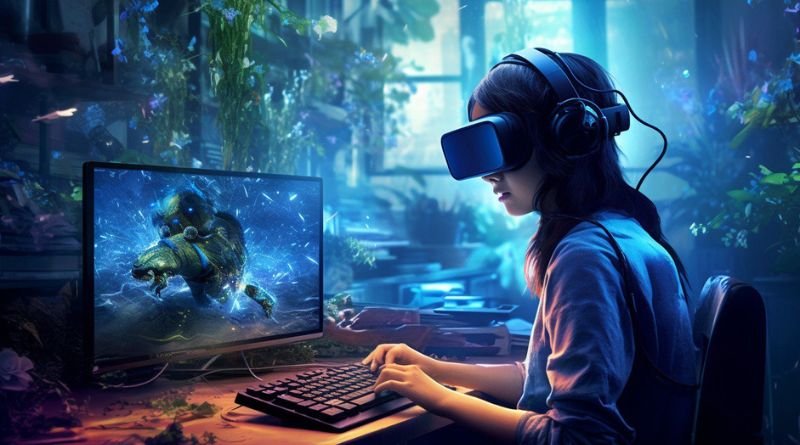Artificial Intelligence (AI) has become an essential component of modern video games, shaping the way players interact with virtual worlds and their inhabitants. From sophisticated enemy behavior to dynamic game environments, AI plays a crucial role in creating engaging and immersive experiences. One of the most significant impacts of AI on game design is the development of smarter, more challenging opponents. This article explores how AI is transforming game design, the benefits it brings to players, and the future of AI-driven gameplay.
Table of Contents
The Evolution of AI in Gaming
The concept of AI in gaming has been around since the early days of video games. In the past, AI opponents were often simplistic, relying on basic scripts and patterns to challenge players. These early AI systems followed predetermined rules, making their behavior predictable and, over time, easy to exploit.
As technology advanced, so did the capabilities of AI in gaming. Developers began incorporating more complex algorithms, allowing AI opponents to react to player actions and adapt to different situations. This evolution has led to the creation of smarter, more dynamic opponents that provide a more engaging and challenging experience.
Today, AI in games is not limited to just enemy behavior. It extends to various aspects of game design, including character interactions, procedural content generation, and adaptive difficulty systems. These advancements have enabled developers to create games that feel more alive and responsive to player input.
Creating Smarter Opponents: The Role of AI
One of the primary ways AI enhances game design is by creating smarter opponents that can challenge players in new and innovative ways. Modern AI opponents are designed to think, strategize, and adapt to the player’s actions, making each encounter unique and unpredictable.
For example, in stealth-based games, AI-controlled enemies can analyze the environment, track the player’s movements, and adjust their patrol routes to increase the challenge. In strategy games, AI opponents can develop and execute complex strategies, forcing players to think critically and adapt their tactics.
Machine learning, a subset of AI, has also been used to create more intelligent opponents. Machine learning algorithms can analyze vast amounts of gameplay data to learn and improve over time. This allows AI opponents to become better at predicting player behavior and countering their strategies, resulting in a more challenging experience.
Moreover, AI can be used to create opponents that adapt to the player’s skill level. This dynamic difficulty adjustment ensures that the game remains challenging for players of all skill levels, preventing frustration for beginners and boredom for experienced players.
The Benefits of AI-Driven Opponents
AI-driven opponents offer several benefits to both players and developers. For players, the most significant advantage is the increased challenge and immersion that AI provides. Smarter opponents make the game world feel more realistic, as players must constantly adapt to new threats and challenges.
AI also enhances replayability. Since AI opponents can adapt and change their behavior, each playthrough can feel different, encouraging players to return to the game multiple times. This variability keeps the gameplay fresh and exciting, even after multiple play sessions.
For developers, AI-driven opponents reduce the need for manual scripting and design. By creating AI systems that can generate behavior dynamically, developers can save time and resources while still providing a rich and engaging experience. Additionally, AI can help identify and fix gameplay imbalances by analyzing player behavior and adjusting the difficulty in real-time.
The Future of AI in Game Design
As AI technology continues to evolve, its impact on game design is expected to grow even more profound. One of the most exciting possibilities is the integration of AI-powered natural language processing (NLP) and conversational AI. This could allow players to interact with in-game characters more naturally, leading to deeper and more meaningful interactions.
Another area of growth is AI-generated content. Procedural generation, powered by AI, can create vast, detailed game worlds with minimal developer input. This technology can be used to generate levels, quests, and even entire game narratives, providing endless possibilities for exploration and discovery.
AI’s ability to learn from player behavior is also likely to improve. Future AI systems could analyze player preferences and tailor the game experience to match individual playstyles. This personalized approach could create a more immersive and enjoyable experience for players.
FAQs
Q: How does AI create smarter opponents in games?
A: AI creates smarter opponents by using algorithms that allow enemies to analyze the environment, react to player actions, and adapt their behavior. Machine learning can also help AI opponents learn from gameplay data and improve over time, making them more challenging.
Q: What are the benefits of AI-driven opponents in games?
A: AI-driven opponents provide a more engaging and immersive experience by creating unique challenges and increasing replayability. They also reduce the need for manual scripting, saving developers time and resources.
Q: How does AI adapt to a player’s skill level?
A: AI can use dynamic difficulty adjustment to analyze a player’s performance and adjust the challenge accordingly. This ensures that the game remains enjoyable and challenging for players of all skill levels.
Q: What is the future of AI in game design?
A: The future of AI in game design includes advancements in natural language processing, AI-generated content, and personalized gameplay experiences. These innovations will lead to more immersive and dynamic games.
Q: How does machine learning contribute to AI in gaming?
A: Machine learning allows AI to analyze gameplay data and improve its behavior over time. This results in smarter, more adaptive opponents that can challenge players in more complex ways.
AI’s impact on game design is undeniable, as it continues to create smarter, more challenging opponents and dynamic game worlds. As technology advances, AI will play an even more significant role in shaping the future of gaming, providing players with richer, more immersive experiences. The fusion of AI and game design is an exciting frontier that promises to push the boundaries of what games can offer.

